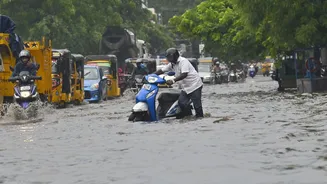Chennai Under Water
The city of Chennai recently faced substantial rainfall, leading to widespread disruption and infrastructural damage. Roads and the airport runways were
severely waterlogged, causing considerable inconvenience for commuters and affecting air travel. The intensity of the rain created significant challenges, highlighting the vulnerability of the city's infrastructure during extreme weather events. The immediate impact included traffic congestion, delays, and potential safety hazards. The accumulation of water across critical areas demonstrated the urgent need for enhanced drainage systems and improved preparedness for such situations.
Bengaluru on Alert
In contrast to Chennai, Bengaluru was placed under a heavy rainfall alert, signaling an impending threat of similar weather conditions. Authorities issued warnings in anticipation of significant downpours, urging residents to take precautionary measures. The alert system aimed to inform and prepare the public for potential disruptions, emphasizing the importance of staying informed and adhering to safety guidelines. This proactive approach underscores the crucial role of weather forecasting and early warning systems in mitigating the impact of extreme weather events, ensuring the safety and well-being of the population.
Infrastructure Challenges Unveiled
The heavy rainfall in Chennai exposed the limitations of existing infrastructure. Waterlogging on roads and airport runways revealed vulnerabilities that demand attention. These incidents pointed out the need for robust drainage systems, upgraded infrastructure, and efficient disaster management protocols. Addressing these infrastructure deficits is crucial for ensuring the smooth functioning of essential services and preventing future disruptions. The challenges highlighted the importance of proactive measures such as infrastructure upgrades and emergency preparedness to effectively tackle and manage extreme weather patterns.
Factors Behind Rainfall
The occurrence of heavy rainfall is attributed to various meteorological factors. While the specific causes may vary depending on the region and the timing, common elements often contribute. These could include monsoonal patterns, cyclonic activities, or regional climatic conditions that bring about intense rainfall. Understanding these underlying factors helps in predicting weather patterns and preparing for extreme events, enabling authorities to implement timely measures. Furthermore, knowing the key contributors offers insight into the overall climate variability within the region.
Preparedness and Response
Effective disaster management and emergency response strategies are critical for handling extreme weather events. Such strategies should incorporate several key elements. These include accurate weather forecasting, rapid response capabilities, comprehensive evacuation plans, and readily accessible resources. Furthermore, the role of public awareness and education is paramount. By understanding the risks, people can take the necessary precautions. Effective measures and prompt responses during a crisis can help reduce the adverse impacts and ensure the safety of citizens.
















